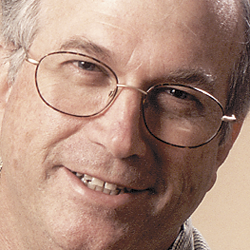|
management

After serving as senior vice president and chief operating officer at American Express Co. for 21 years, John Baker formed Ready Thinking LLC and began traveling the country speaking about change management, leadership, and effective persuasion. He also currently serves as an expert with the U.S. Department of Defense's Yellow Ribbon Reintegration Program, where he helps veterans adapt back to civilian life after overseas deployments. Baker published his first book, "Ready Thinking – Primed for Change," in 2009, and followed up with his second title, "The Asking Formula," in 2012.
illustration: Scott anderson
Asked and Answered
Author, EXHIBITORLIVE faculty member, and self-proclaimed asking expert John Baker talks about the power of persuasion – and shares his tips for getting what you want, every time. By Claire Walling
Asking for the things you need seems as easy as apple pie, but according to John Baker, many people – from kids looking for some extra homework help to event marketers advocating for significant budget increases – struggle to articulate exactly what it is they're after. And Baker should know; as chief operating officer for American Express Co. he saw his staff stumble even when making simple requests, and that experience prompted him to write "The Asking Formula" and "Ready Thinking – Primed for Change."
Instead of standing in front of your boss and word vomiting for 20 minutes about every miniscule detail of your plan, Baker says that marketers should implement his simple six-step approach to ask point-blank for the resources they need to succeed. Here, he explains everything from the tenets of The Asking Formula to the importance of persuasion for trade show and event marketers. EXHIBITOR Magazine: First off, what is The Asking Formula, and what steps does it involve? John Baker: Quite simply, The Asking Formula is a template you can use as a quasi-script for successful negotiations. Before I say anything else, it's vital to understand that the six steps of the formula are repeatable, so you can use them with a variety of internal and external audiences. The first step, then, is to be very clear about your objective. What is it that you want? I can't stress how important that is. Many times during role-playing exercises people actually get halfway through the formula before turning to me and saying, "That's not actually what I want." The second step is to ask in plain language for what you want – don't bury it within the conversation. Make sure people understand the specific reason you're standing in front of them. Next, proceed to the third step of the formula. This is where you demonstrate or show what you're asking for. People like to learn visually, so if you can, hold up an object or a photo that effectively illustrates your request. Fourth, follow up with something I call best reasons. Best reasons can be defined as what's in it for your audience if they say yes to your request. These need to start with one of four words: you, your, our, or we. They can never start with I, me, my, or mine because words that put the focus on yourself are not influential. The fifth step is to stop talking. Know when to be quiet. If you know how to stop, it allows you to project confidence in your personal and professional brand. The last step, step six, is to share. That's having the moxie and intuition to know when to provide more information and elaborate in greater detail, and when it would be more persuasive to thoughtfully curate the information you disseminate to your audience. Those are the six steps of The Asking Formula. And it is literally a formula. I have a form you can complete that doubles as a cheat sheet so before you ask your boss for a bigger budget or a promotion, you can practice it and master it. EM: What prompted you to write a book about how to effectively ask for things in the first place? JB: One of the reasons I wrote the book stems from my experience as chief operating officer at American Express Co. What I found was that as talented as my staff was, they had a hard time asking me for the things they needed in order to succeed. If they couldn't ask me for what they needed, then how in the world were they going to go across the organization, across the country, or across the globe and ask others for what they needed? The Asking Formula was initially about leadership competency, but I also incorporated it into our sales process as well. Sales is about asking: asking for appointments, asking for information, asking for the sale, asking for referrals. Whatever needs to happen in the sales process, you have to ask for it. That's just the nature of the business. But quite frankly, the most important reason why I wrote the book was for my kids. I wanted to lay out a good, basic life skill for them. How do you ask the teacher for more help? How do you ask the coach for more playing time? How do ask for your first job interview, and when you get your first job, how do you ask for your next promotion? These are the three main touchpoints for why I developed The Asking Formula and why it's been so popular to date. 
JB: When you think about exhibitors and event managers, they're leaders within their respective organizations. Think of how many times during the day they have to ask for what they want. They have to go and ask their boss for budget increases so that they can have a bigger presence at a show, or perhaps they have to ask for cooperation across the organization to get the personnel they need to man the booth. At the show itself you can have the best graphics, visuals, or giveaways, but if you can't engage with someone directly on the floor and ask them to listen to you, then your efficiency at the event will suffer. EM: Do you have tips for readers for when they negotiate with their boss, say for a larger budget or raises for themselves or their employees? JB: First and foremost, be specific. If you're asking for an increase in your budget, know exactly what percent increase you want. What quarter do you want to spend it in? What do you want to spend on each line item? People who would come into my office in my role as chief operating officer at American Express would ask for more budget, and I'd give them 2 percent. Then they'd say, "But I wanted 10 percent." And I'd say, "Ah, but you didn't ask for that, and I had to make a decision of how much to give you." If you're not specific, you probably won't get what you want. The second thing is be very direct with your boss. Don't beat around the bush; don't give a long-winded presentation. When you ask directly for what you want, you put your audience on notice that this is the purpose of the conversation. So many times when we lead with information, we leave thinking we've been persuasive. Instead, answer this question: How will the boss look in front of his or her boss if he or she allows this allocation? When you put your audience first – and you have to regard your boss as an audience member – you have to make sure you articulate to him or her the reasons that he or she should want to say yes to you. As long as you put that language into play, your boss is going to be much more open to persuasion than if you just came in with a presentation and said "I want more money for my program." EM: You mention that exhibit managers ask for things every day, and one of the scenarios they often run into is asking show management to approve variances or out-of-the-box ideas. How would The Asking Formula apply in this particular situation? JB: This scenario fits perfectly with The Asking Formula. Start by knowing specifically what it is that you're after. Many people think they know that, but then they get confused and can't communicate clearly. Say, for instance, that you want to ask show management to create a sponsorship package tailored to your company's goals at the show. You're going to call the show manager and ask him or her directly for what you want, putting them on point for what the conversation is all about. Don't lead with information about why your idea is good for the show or about your background; that's confusing to your audience. A lot of people think that information is a vehicle for persuasion, but it actually gets in the way because your audience has to process exactly what it is you're asking for. Next, you have to get into the mind of the show manager. What is he or she trying to achieve with this event that would allow him or her to see that your idea makes sense? Is what you're asking for going to help them to be innovative? You can have really cool ideas, but they won't resonate with your audience if they're self-centered. 
JB: I always believe in being direct and open. Approaching somebody who's in the event hall and saying "I'm asking you for 30 seconds of your time to learn about X, Y, and Z" is a very disarming approach. People get it. When everyone is trying to get attendees to drop their business card into a fishbowl or enroll for a free massage, why not just be direct? You know what, you may get a "no thank you" or two, but you'll also get more people to say yes that way. When you get attendees to accept your invitation to come into the booth, the dialogue has to be 80 percent about them. Learn what they're doing at the show, what they've seen that's been interesting for them, and why they're attending the show in the first place. Really get into their mindset during that short period of time that you're standing with them in your booth. Don't start showing them your products. When you show your stuff, it becomes about you, and that's not persuasive – and people want to feel they are being listened to. Once you get an information-based conversation rolling, you're getting people to open up to you. Write down important facets of what attendees are telling you about their needs and their businesses. Then use that information later. Reminding them, for instance, of the three most important things they're looking for when you're making follow-up phone calls will be invaluable. Other exhibitors just try to rush you in, bang you over the head with their marketing materials, and then send you on your way. What good is that? Why not make it about the attendees – what they've seen at the show, what they're looking for, etc. Those types of questions really push people to open up about themselves. EM: In a nutshell, why is the ability to effectively ask for what you want so important in business? JB: Asking can be a true differentiating attribute for you and your company. Many of the things we believe are key differentiators are either quickly matched or effectively neutralized by our competition, but the ability to influence someone and get them to say yes by using The Asking Formula is something that can't be imitated. Effective persuasion will do more to boost your company's bottom line than fancy product literature, over-the-top exhibits, or swanky off-site events ever could. E
Recommended Reading
 Want to learn how to stay resolute when faced with daunting transitions? The five principles outlined in John Baker's first book, "Ready Thinking – Primed for Change," will help you achieve that. The book intertwines actionable advice, real-life examples of leaders who embraced change, and worksheets for implementing the ideas detailed in the previous chapter.  In "The Asking Formula," Baker outlines his straightforward strategy for effective negotiations. Baker will walk EXHIBITORLIVE attendees through this foolproof method during his session (T713 The Asking Formula: How to Ask for What You Want – And Get It). To learn more about EXHIBITORLIVE and register for Baker's session, visit www.ExhibitorLive.com.
|
|
|
||||||||||||||||||||||||||||
|
|
||||||||||||||||||||||||||||
|
TOPICS Measurement & Budgeting Planning & Execution Marketing & Promotion Events & Venues Personal & Career Exhibits & Experiences International Exhibiting Resources for Rookies Research & Resources |
MAGAZINE Subscribe Today! Renew Subscription Update Address Digital Downloads Newsletters Advertise |
FIND IT Exhibit & Display Producers Products & Services All Companies Get Listed |
EXHIBITORLIVE Sessions Certification Exhibit Hall Exhibit at the Show Registration |
ETRAK Sessions Certification F.A.Q. Registration |
EDUCATION WEEK Overview Sessions Hotel Registration |
CERTIFICATION The Program Steps to Certification Faculty and Staff Enroll in CTSM Submit Quiz Answers My CTSM |
AWARDS Sizzle Awards Exhibit Design Awards Portable/Modular Awards Corporate Event Awards Centers of Excellence |
NEWS Associations/Press Awards Company News International New Products People Shows & Events Venues & Destinations EXHIBITOR News |
||||||||||||||||||||
|
||||||||||||||||||||||||||||






